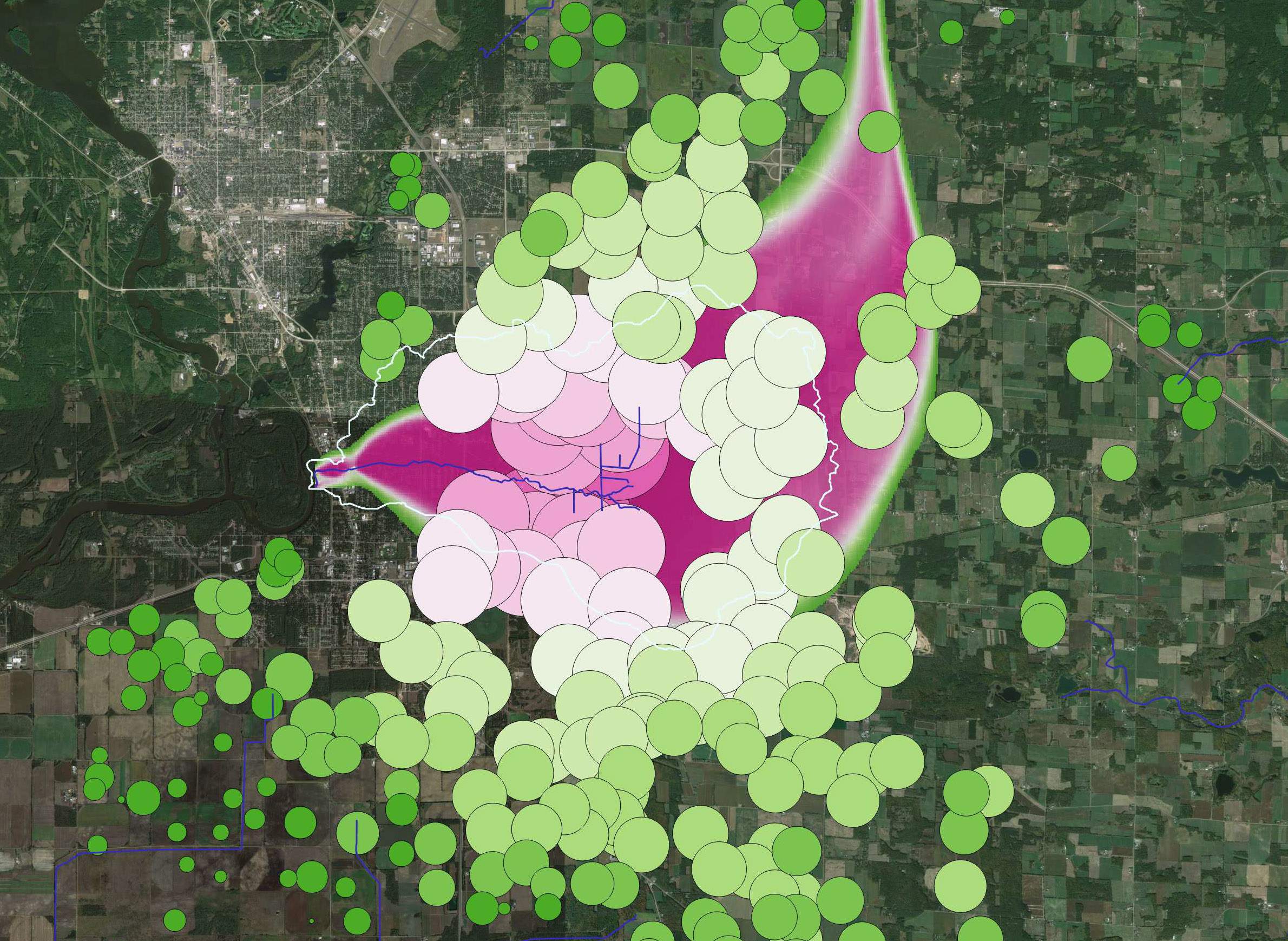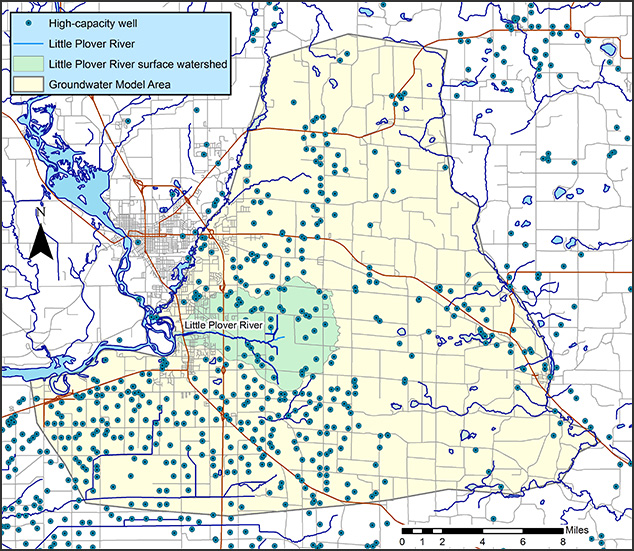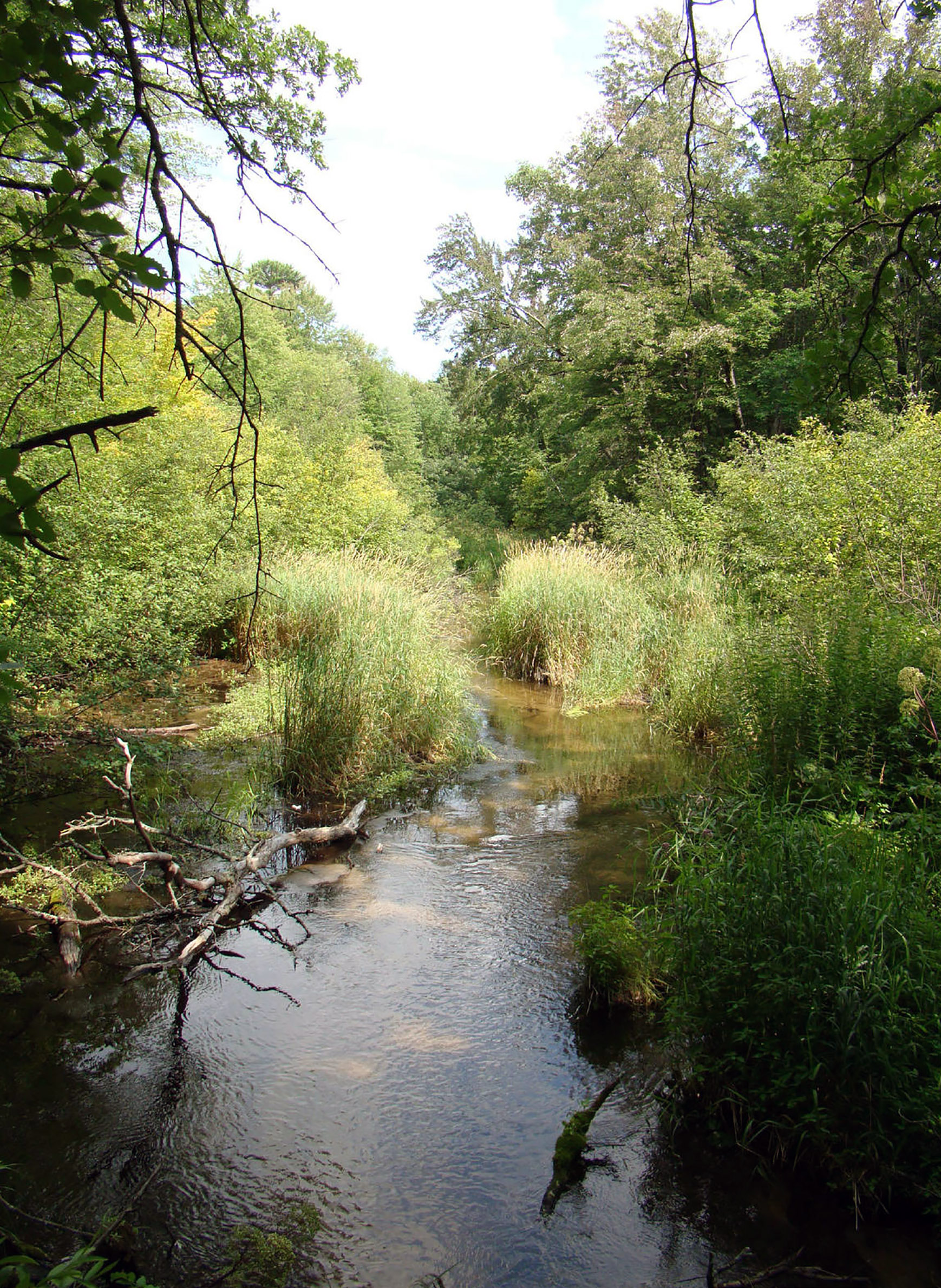
The Power of Computer Models To Inform Groundwater Disputes

A natural abundance of water, both above and below ground, is one of Wisconsin’s most defining assets. The resource has made possible much of what anchors the state's economy, from tourism and agriculture to paper milling and brewing.
Even in water-rich Wisconsin, though, the use of groundwater for municipal water systems and agricultural irrigation can lead to conflict through reducing flow to ecologically and economically important surface waters. One powerful tool for helping resolve these conflicts is a groundwater flow model. These mathematical computer models help make possible the complex task of understanding how groundwater use affect streams, rivers, lakes and wetlands.
Scientists at the Wisconsin Geological and Natural History Survey use groundwater flow models to map the effects of high-capacity wells on local aquifers around the state. These models can focus on municipal wells, such as one examining the Yahara lakes in Dane County, and another focused on Portage County's Little Plover River and how it is affected by agricultural irrigation wells.
The Little Plover is an important trout fishery within a productive agricultural region. In recent years, reduced flow in the river has spotlighted the area's dependence on high-capacity irrigation wells even as stakeholders lacked a precise accounting of their impact.
Enter groundwater models, which have helped decision makers better understand the complex flow of groundwater beneath their communities, pinpoint likely culprits of reduced surface flow and troubleshoot potential solutions.
A simple way to grasp how drawing water from deep beneath the ground reduces flow at its surface is to think about groundwater a bit like a bank account, explained Wisconsin Geological and Natural History Survey director and state geologist Ken Bradbury. He described the basics of groundwater modeling in a Sept. 28, 2015, talk at the University of Wisconsin Arboretum recorded for Wisconsin Public Television's University Place.
The balance of groundwater present in a system is called its water budget. In a natural system without wells, the amount of groundwater leaving the system via springs, wetlands and lakes roughly equals the amount replenished by precipitation, much like a balanced checking account. On the other hand, aquifers that are tapped by wells that withdraw large amounts of water end up with a water deficit, meaning more water is leaving the system than is being recharged by rain and snowmelt.
In Wisconsin, the Department of Natural Resources regulates high-capacity wells, which are defined as having the capacity to withdraw more than 100,000 gallons of water per day individually or in combination with other wells on a single property. But understanding precisely how an individual high-capacity well may affect a regional groundwater system is complicated in the real world, said Bradbury, because many factors contribute to an aquifer's water budget, not simply the daily capacity of a single well. This layer of uncertainty and the sheer amount of relevant geological data that contributes to it is where the computational potency of a groundwater flow model comes in handy.
After comparing modeled maps against real-world observations, the Survey uses them to understand where and how wells are affecting a water table.
Additionally, and crucially, scientists can use models to test hypotheses about how different management systems may affect an aquifer in the future. That's what the Survey did in the region around the Little Plover River, where it worked with local stakeholders to identify wells that might be good candidates for shutting off based on their location, their importance for irrigation and the individual role they play in reducing the river's flow.
Even still, settling on a workable solution to the problem is not as straightforward as identifying it. In 2016, the Survey revealed its study of high-capacity wells in the Little Plover watershed, finding that the proximity of wells to to the river was meaningful. A year later, Bradbury and his team of researchers confirmed that wells are indeed reducing its flow. Since then, public and private sources have funded a project to the tune of $2.6 million to restore the river's flow using the Survey's groundwater flow model as a basis for the effort. Meanwhile, the DNR is using the model in a lake levels study in the region.
These applications point to the ways groundwater modeling can help policymakers to address conflict between competing interests for water use.
"So often in these water resource conflicts, I see people arguing about pros and cons, and there's a lot of misinformation or mistaken information sometimes or opinions that can't be backed up," said Bradbury. "Models are factual things … we can put in the mathematics and the mathematics don’t lie, so they give unbiased and objective solutions."
Key facts
- Wisconsin Geological and Natural History Survey scientists use computer models to better understand and forecast groundwater budgets.
- Groundwater is any water that fills a crack, pore or space beneath the Earth's surface. It sustains springs, lakes, streams and wetlands, and in Wisconsin it also provides a large share of drinking and irrigation water.
- Precipitation is groundwater's only source, and about 20-30 percent of precipitation eventually becomes groundwater.
- A groundwater budget represents the balance between groundwater outflows — via springs, lakes and wells — and its natural replenishment by way of precipitation. When more water is drawn from an aquifer than is replaced, scientists consider the aquifer to have a groundwater deficit.
- Groundwater deficits can lead to lower levels in nearby surface waters, which often carry negative consequences for aquatic life and human activities.
- Building a groundwater model begins with understanding the geology and water resources of a particular place, and then converting that knowledge into a mathematical formulation that scientists can feed into a modeling program. This geological and hydrological information is then split into small parcels, much like pixels in a digital image. Together, these small bits of information form a regional groundwater picture computer models can use to produce maps that provide predicted water levels, flow rates and paths.
- Groundwater models are powerful tools because they are robust enough to forecast groundwater budgets based on large amounts of complex data while nimble enough to forecast small differences based on potential management scenarios.
- By forecasting groundwater budgets, scientists can help local communities make decisions about current and proposed water and land use.
Key quotes
- On the impacts of groundwater use in Wisconsin: "We have abundant water in most places compared to other parts of the world, but we do have some issues ...The issues are often a deficit in our water budget, and the deficit is something we can see because we see decreased base flow to springs, streams, lakes and wetlands. That’s the most obvious impact of groundwater use that we see in Wisconsin."
- On using a location's geology and water resources when building a model: "We look at the properties of rocks. We would investigate springs, for example, [and] measure flow in springs and streams. We would do a lot of what we call 'geophysics,' lowering different probes down wells to measure things about the rocks and water below the surface."
- On groundwater models using complex on-the-ground information to better understand water use impacts: "They integrate impacts from multiple stresses or multiple wells, so we can solve questions involving many, many wells at once … We get a complete water balance, we understand where all the water is coming or going, and the models are also a database of information."
- On using groundwater models to gauge water use over time: "One of the neat things we can do with the models [is] we can look back in time, and then we can add the wells and see how things have changed."
- On using groundwater models in water resource conflicts: "They're based on mathematical and physical properties, and so they give objective results [and] objective solutions. So often in these water resource conflicts, I see people arguing about pros and cons, and there's a lot of misinformation, and mistaken information sometimes, or opinions that can’t be backed up. Models are factual things, and we can put in the mathematics, and the mathematics don’t lie, so they give unbiased and objective solutions."
- On modeling the effects of broader environmental issues: "We can also look at things like climate change. How is groundwater going to respond to that? [And] land use change. If we take some fields out of production or we pave them over, how is that going to affect things?”
- On the use of groundwater models in decision-making: "Models are really … decision support tools for understanding the impacts of new wells, for understanding alternatives, for looking at these groundwater-surface water relationships, understanding where water comes from, from a spring or a lake, to a spring or a lake, and how changing the environment might change that flow."




